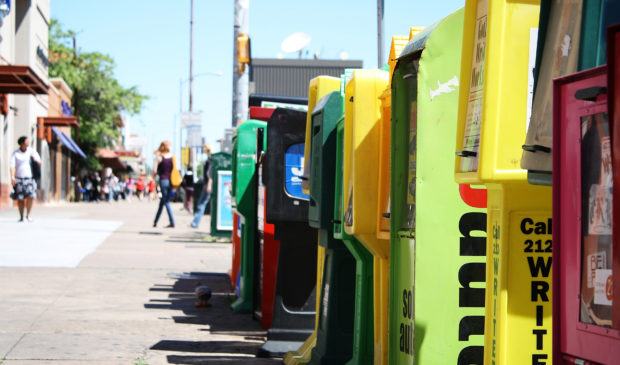Guadalupe plan no roadblock for Project Connect
Friday, December 8, 2017 by
Caleb Pritchard The city’s newly published Guadalupe Corridor Plan unsurprisingly turned heads when the Austin Transportation Department published it on Tuesday.
Any plan that recommends the elimination of on-street parking and conversion of general purpose lanes into transit-priority lanes can be reliably counted upon to draw swift reaction from car-friendly quarters, including no less a person than Gov. Greg Abbott himself.
But the plan also raised eyebrows among local transit advocates over one large issue left entirely unaddressed in the plan’s 66 pages: Project Connect.
The Capital Metropolitan Transportation Authority earlier this year identified Guadalupe Street as a potential investment corridor for high-capacity transit. Planners have insisted that the process is entirely agnostic and no visions have been predetermined. Likewise, city staff has held that it is waiting for the results of Project Connect and will work with Capital Metro to implement the wishes of the community.
However, on Tuesday, former member of the Urban Transportation Commission and local transit pundit Mike Dahmus tweeted, “Despite Capital Metro assuring everybody for 2+ years that they arein (sic) lockstep with the city with Project Connect, the city just released a plan that precludes light rail (for a generation or more) on Guadalupe/Lamar.”
Dahmus elaborated in a subsequent tweet, declaring, “You don’t rebuild a road like this only to tear it up a couple years later to put rail down.”
On Thursday, Capital Metro long range planning director Javier Arguello told the Austin Monitor that any implementation of Project Connect’s ultimate recommendations will likely be realized as late as a decade from now.
“So if the city decides to move forward with the recommendations of the Guadalupe Corridor Plan as they are in that plan, those changes in that section of the corridor will be in service for at least six, seven or eight years until the infrastructure of Project Connect comes, if it is supported by the community and we find the money,” Arguello said.
Of course, there’s no guarantee that the city will move forward with every detail within the Guadalupe plan. The city’s Corridor Implementation Office will use the document, whose recommendations total up to $33 million, as a guide as it builds the corridor implementation plan that Council will consider in early March. That final package will feature $482 million worth of projects plucked from seven other corridor plans.
While Arguello praised the Guadalupe plan’s prioritization of transit along the street’s outside lanes, he noted that the configuration would not necessarily be ideal for a high-capacity transit system such as light rail or bus rapid transit.
“It’s not necessarily the fastest solution for us or the most economic way to do it because we will have to duplicate stations. If we are running in the center lanes, we have one station,” he explained. A center-running alignment would also save money on overhead wires and its stops would be less intrusive on commercial and pedestrian areas, he added.
As for the 20 bus routes that currently operate on Guadalupe Street, Arguello said that a potential high-capacity transit system would necessitate a reduction of local service in the corridor. The aim would be to transfer as many riders as possible from those lines to the new light rail or BRT system, he said.
The particular characteristics of the Drag – constrained right of way and a diverse blend of modes – would also influence the type of vehicles Project Connect would recommend. Given lower densities and likely larger stop spacing outside of the heart of the city, a light rail train would need to be able to achieve relatively high speeds.
“But at the same time, it has to be a technology that can mimic what a modern streetcar will do in a circulator setting,” Arguello said. “So it will have to be a train technology that can operate on low speeds, can make frequent stops and more importantly can interact in a pedestrian environment.” As examples, he cited the light rail systems in both Portland, Oregon, and Houston.
Project Connect will unveil its recommended projects in April. Arguello and his team will spend the rest of 2018 working to identify potential funding sources.
In the meantime, they will also play a more active role in a new batch of corridor planning efforts. The 2016 mobility bond that will pay for the city’s corridor implementation plan also included money for new studies of busy roadways, including North Lamar Boulevard between U.S. Highway 183 and Lady Bird Lake, and South Congress Avenue.
“We are coordinating with their consultants and public involvement teams. We are sending our staff to their meetings and they are sending their staff to our meetings too,” Arguello said. “We really don’t want to confuse the community with all these different initiatives.”
Photo by Derek Key made available through a Creative Commons license.
The Austin Monitor’s work is made possible by donations from the community. Though our reporting covers donors from time to time, we are careful to keep business and editorial efforts separate while maintaining transparency. A complete list of donors is available here, and our code of ethics is explained here.
You're a community leader
And we’re honored you look to us for serious, in-depth news. You know a strong community needs local and dedicated watchdog reporting. We’re here for you and that won’t change. Now will you take the powerful next step and support our nonprofit news organization?









